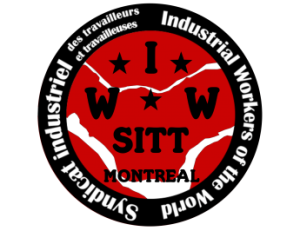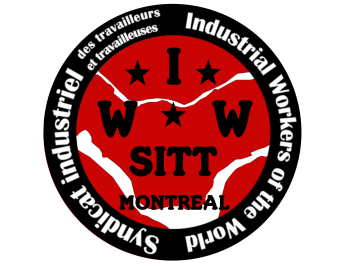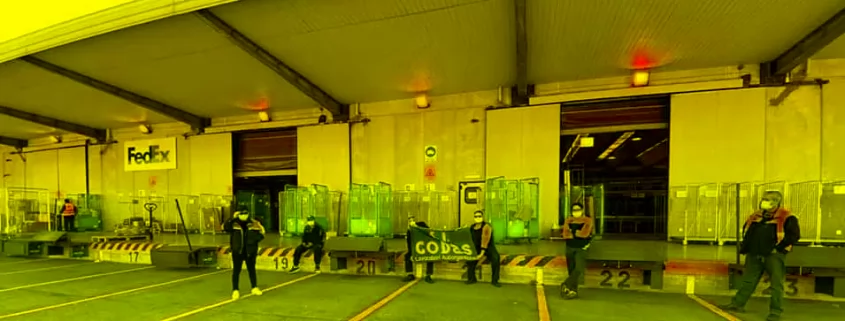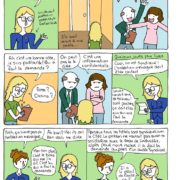HOW THE PANDEMIC TRIGGERED A WAVE OF STRIKES IN ITALY
Morgan M takes a look at the wave of strikes in Italy in light of the coronavirus pandemic and government and industry responses, interviewing an activist firefighter in a local grassroots union. Image: Workers at TNT FedEx facilities in Genoa and Bologna on strike 7 April for safer conditions.
When COVID-19 hit Italy, the government tried to isolate people while letting the economy roll. As the government banned gatherings and stressed the importance of isolation, he was also pushing workers to keep showing up for work, whatever the conditions. This contradiction caused a wave of wildcat strikes across the country.
In Italy, Labor is generally negotiated at two levels: sectoral agreements setting industry standards and specific agreements set for a particular company.
There are three major trade union confederations (like the CSN, the FTQ, and the CSQ) as well as two small right-wing confederations. The three major confederations are the CGIL, which is the largest and affiliated with the Communist Party ; the ICFTU which was a Christian democrat ; and the UIL which was affiliated with the Socialist Party.
On a national level, the union confederations negotiate with theConfindustri, which represents employers and government in a kind of tripartite social partnership.
At the company level, there are “work councils” which represent the workers. All unions that have the support of more than 5% of employees (there is no Rand formula like in Canada) can participate in the council. There are two types of councils where the strength of the union depends on the breadth of membership within the company. The two types differ depending on whether unions appoint shop stewards or employees elect them..
in parallel, there are the Cobas unions – theCOmoths of theBASe (union). There are many Cobas unions, ranging from the very small to those who are between 40 and 50 000 members. They operate similarly to the Industrial Workers Union-IWW in North America., i.e. organized inside and outside the legal structure of work. SI Cobas has drawn attention for being able to organize strikes in the logistics sector. SI Cobas will often strike until the end (until a resolution is reached) as opposed to limited strike, which is a more common tactic.
Sadly, the different Cobas union leaderships often see each other as rivals and do not strike together.
I had the chance to interview Mariopaolo, a firefighter and grassroots activist of the Cobas union "Unione Sindacale Di Base" (USB), about the strikes that took place there. He's been working there for a few years., fighting for USB to stay out of national agreements in order to maintain its freedom to strike. He is also active in a coordination of grassroots Cobas activists, encouraging unity of action between the different Cobas unions.
When the pandemic broke, Italy has started isolating individuals in the north of the country. Can you explain the reaction of the working class to the limitation of workers' actions ?
In Italy, as in most countries – especially those where capitalism is old – the working class has for years been marked by a general passivity.
In this general passivity, a government deciding to limit the freedom of action of unions is not seen by most workers as a problem. Indeed, if we are no longer used to using a protest tool (strikes, assemblies, stakes), when it is taken away from us, we only notice it in principle: in the facts, we no longer notice his absence.
However, there were exceptions. Friday 4 mars, ArcelorMittal – the largest steelmaker in the world, owner of both Bethlehem and Republic Steel in the United States – has reached an agreement with the government over redundancy plans and dismissals at its steel mills in Italy. At the Genoa steelworks, the FIOM-CGIL union – the largest union for metalworkers and autoworkers in Italy – called a factory meeting on 9 mars, what they can do at any time for union matters. ArcelorMittal banned the meeting citing the social isolation decree the government issued that day. The FIOM union at the steel plant replied that it would declare a strike and hold a meeting outside the plant. The next days, however, the spread of the epidemic has worsened considerably, which led to the dismissal of the assemblies.
However, it should be noted that neither the government decree of 4 March nor subsequent decrees banned strikes. Therefore, for fear of contagion, that is, to defend their own health, workers went on strike in many factories over the next few days.
Has the government made it compulsory to work in isolation areas ?
The government did not stop essential activities before the 23 mars (we will come back to this later). The first cases were discovered 21 February in 10 small towns of a few thousand inhabitants in the province of Lodi (in Lombardy, south of Milan) and in a small town in the Veneto region. The government closed these 11 municipalities as “red zones”, from which no one could enter or leave. As these were small municipalities, it was difficult for the companies located there to continue production because a more or less significant part of their staff lived in other municipalities ; and these workers could therefore no longer access their jobs in the red zone. It should also be noted that these companies no longer had access to the raw materials and semi-finished products necessary for production..
However, the situation has changed 9 mars, when the government created a much larger red zone, which included the entire region of Lombardy and 14 provinces of other regions.
Thereby, the government has extended its control over the movement of people and the limitation of demonstrations, meetings and gatherings in a third of the national territory. But since no production shutdown had been announced, the companies of 11 red areas of the original municipality were able to resume production.
The same thing happened on 11 mars, when the government extended the red zone to the entire national territory.
These measures to extend restrictions on movement and assembly have begun to worry workers, which had the effect of causing them to go on strike in many factories.
Strikes spread across the country. It should be noted that the latter were not instigated by the leaders of the regime's unions. (CGIL, CISL, UIL – the trade union centers that sign the national agreements), which had not happened in Italy for many years.
The 14 mars, in front of this situation, the trade unions of the regime have signed an agreement with the government and the largest organization of Italian industrialists (the Confindustria) aimed not at stopping non-essential production, but rather to guarantee safety measures for workers.
Was there a legal way to protect yourself at work?
Government decrees have established mandatory measures to mitigate the risk of contagion. In several cases, unions have used these legal provisions to impose temporary layoffs on employers pending the implementation of these measures, as provided for in the protocol of the 14 mars.
Where unions and companies failed to reach an agreement on temporary layoffs, strikes were organized. In some cases, the unions said they were not strikes but “abstentions from work”. It goes without saying that a strike is nothing but collective abstention from work.. However, this distinction was probably used by unions – and workers – in the hope that unemployment benefits would be paid, as provided by government decrees.
How did the wave of strikes start? Were they spontaneous? From Cobas Unions? From inside the CGIL?
The strikes began to multiply when the severity of the epidemic became apparent. They are also the product of escalating government measures, of 21 February 11 mars.
We need to clarify what a “spontaneous strike” is. Certainly, workers exerted pressure to strike. In many cases, they have found the support of factory representatives [union delegates] regime unions, who did not oppose the strikes. Some of the regime's regional trade union structures have declared general strikes. This was the case of the IMF (CGIL- automotive and metallurgy) in Lombardy, in Trentino and Turin; and the houses of the FILCAMS-CGIL-CGIL (the trade union CGIL, services and tourism) in Genoa.
These are the national leaders of the confederations – the CGIL, the CISL and the UIL – who did not organize the strike movement in order to stop non-essential activities on full pay. They did not call for a multi-sector national general strike and the 14 March – when the epidemic had already shown its full gravity and caused thousands of victims in northern Italy – they signed the aforementioned protocol.
Base unions – SI Cobas, USB, CUB, ADL Cobas – have called for national strikes in certain industries and, the 25 mars, USB called for a strike in all industries, except for essential workers.
However, these unions do not have the strength to promote real general strikes, even within corporate industries, with the exception of SI Cobas, located in logistics. Even after the 8 and 11 mars (with the extension of the red zone first to the whole of Lombardy and then to the whole country) and the multiplication of strikes which resulted, national strikes by Cobas unions failed to involve a significant portion of workers. This is due to the fact that the trade unions of the regime – although supporting the strikes that took place at the corporate and regional level – never try to unify the strikes at the national level.. Furthermore, even in this situation conducive to the mobilization of workers, the leaders of the Cobas unions refused to unite and continued to wage war on each other.
How were these strikes organized?
Strikes are the expression of a grassroots movement on the part of workers who, in the face of calls from the government to remain confined, found themselves forced to go to work with an obvious risk of contagion. Union delegates are themselves subject to this double constraint, this partly explains their broad support for strikes.
On another side, the lack of unification of the strikes not resulting in a national strike of all categories of work, aimed not only at not exposing workers to the risk of contagion but also at obtaining full wages, prevented the extension of the strikes. These strikes are thus limited to the areas where the epidemic was the most important, where workers were grappling with the choice “health or wages”.
CGIL and other unions seek to work with companies, like the UAW does in the United States (or the major power stations in Quebec). If I understand, the CGIL tried to work with the industry but did not succeed and wildcat strikes then broke out ?
The seriousness of the epidemic was already clearly manifested on 8 mars. Faced with the generalization of strikes, the protocol signed by the national leaders of the CGIL, of the ICFTU and UIL – together with government and industry – has enabled the complete closure of non-essential economic sectors to be postponed as far as possible. This protocol provided that the implementation of the measures (health and safety, and containment) is done in concert between the company and the unions in each production sector. The protocol also provided for a temporary suspension of production, with unemployment funds for workers, if no agreement could be reached. If that were the case, the union reserved the right to call a strike.
So, the unions of the regime do not oppose the strikes, but rather reserve the possibility of organizing them. On the other hand, unions have allowed the government to postpone the suspension of non-essential activities until 25 mars, 11 days later.
Compliance with confinement rules (agreements between the union and the company) was possible in companies where the unions of the regime had sufficient strength and where the delegates were combative and combative.
At the end, workers in most small and medium enterprises – where the majority of Italy’s working class works – are left at the mercy of the bosses.
An original text by Organizing Work.






Leave a Reply
Want to join the discussion?Feel free to contribute!